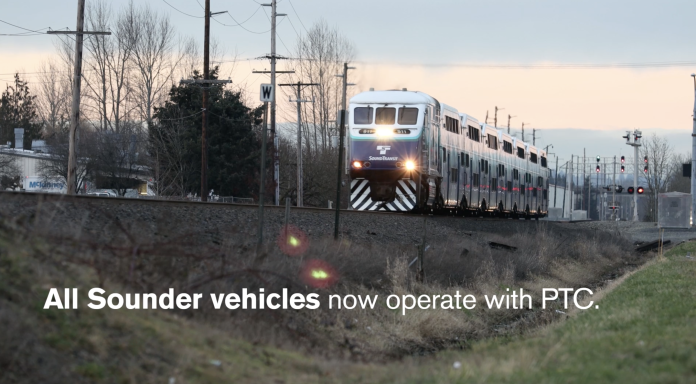On Monday, Sound Transit announced that positive train control (PTC) has been fully implemented and received certification along the Sounder commuter rail corridors. Sounder trains operating the corridors from Lakewood to Everett are now controlled by PTC equipment that automatically slows trains from overspeeds and prevents collisions with other trains, evening stopping the train if necessary.
“Safety is our most important priority at Sound Transit,” said Peter Rogoff, Chief Executive Officer of Sound Transit. “Each and every one of our riders must get home or to work safely every time. Adding positive train control on all our Sounder trains will help us maintain our impeccable track record.”
Sound Transit operates commuter rail primarily along tracks owned by Burlington North Santa Fe, which is shared with freight trains and other passenger rail operators like Amtrak. Active PTC equipment along the corridor and onboard trains can greatly increase safety and avoid crashes. PTC equipment has been installed on 41 Sounder vehicles, along tracks, and in a train operations center. The PTC system was fully implemented in October.
PTC systems can kick in under a number of situations after warning and giving time to the engineer to respond appropriately, including:
- Exceeding ordinary speed limitations on track sections;
- Exceeding temporary speed restrictions, such as a work zone;
- Failure to comply with a signal restriction; and
- Potential collision with another train.
In 2017, Sound Transit began testing PTC on its commuter rail lines, first on the Everett-to-Seattle line in June and then on the Tacoma-to-Seattle line in August that year. The transit agency also equipped its own tracks from Tacoma to Lakewood (known as the “Lakewood Subdivision”) with PTC.
The Lakewood Subdivision will only be shared with passenger trains. Amtrak plans to begin operating the Cascades and Coast Starlight routes on that corridor again this year (the maiden voyage of Cascades service on the corridor ended in a deadly crash in December 2017 and restarted a national conversation on finally fully implementing PTC across the country by the end of 2018). That will not happen, however, until the springtime, pending the National Transportation Safety Board releasing their final report on the Cascades crash. Amtrak will consider any recommendations that are made and consider implementing them. The full Cascades corridor already has PTC activated though.
With PTC activated on the Sounder corridors, wayside radio equipment and global positioning systems are able to track the exact location of trains and automatically kick in vehicle controls, depending upon the situation and location of the trains. Sound Transit reports that PTC works on more than 99% of Sounder trips, but is still short of 100%. The transit agency plans to continue improving the reliability of the system. When the system was first launched, there was a high failure rate of PTC, so getting to this point should still put most safety concerns to rest.
Stephen is a professional urban planner in Puget Sound with a passion for sustainable, livable, and diverse cities. He is especially interested in how policies, regulations, and programs can promote positive outcomes for communities. With stints in great cities like Bellingham and Cork, Stephen currently lives in Seattle. He primarily covers land use and transportation issues and has been with The Urbanist since 2014.


